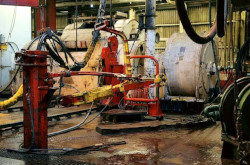Hazards Associated with Working Surfaces
The OSHA standards for walking/working surfaces apply to all permanent places of employment, except where only domestic, mining, or agricultural work is performed.
The rig floor is the working surface for most tasks performed in well drilling operations. This surface is frequently wet from circulating fluid and/or water used to wash it down. Prevailing weather may further increase the slipperiness of the surface.
Employees must lift, push, and pull heavy items as a routine part of their assignments. Slippery working surfaces can increase the likelihood of back injuries and other overexertion injuries. Slips and falls may result in sprains, strains, contusions, and lacerations. Exposed moving parts (rotary table and kelly bushing) may compound the injury potential and severity.
Additionally, the rathole (although usually an elevated tube) and mousehole, used to temporarily store the kelly bar and drill pipe, may be uncovered when not in use. Stepping into a floor hole can result in fractures and sprains.
The cellar is a pit in the ground below the derrick structure. Hydrogen sulfide, if released, and water may accumulate in this low area. Ladder access into the cellar is a potential accident source, as is lack of proper guarding.
Knowledge Check Choose the best answer for the question.
2-7. What can increase the slipperiness of oil rig floors?
You forgot to answer the question!

